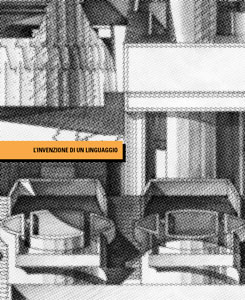
An architectural lesson by Franco Purini
In schools of architecture focused on scientific processes and methods, the foundational and generative issues of form are rarely discussed. As if it were possible to teach architecture without mentioning language, grammar, syntax, and even less poetics, and thereby omitting the subjects that distinguish architecture from the building trade and make it an art. In this context, the questioning of the reasons and methods that characterise the problem of architectural composition at its root is a counter-trend operation that finds a dense and personal response in Franco Purini's work, strongly oriented towards the transmissibility of making architecture. Investigating the "how" as well as the "why", delving into the mysterious fields of invention with the instruments of reason, is a necessary choice in order to make the compositional process transmissible.
With this aim in mind, the volume L’invenzione di un linguaggio. Franco Purini e il tema dell’origine 1964-1976 edited by Roberta Albiero focuses on the architect's language and its genesis.
The book collects and develops the testimonies of the homonymous exhibition staged at the Iuav headquarters in Tolentini in 2019, to celebrate the donation of the Purini Thermes archive to the Iuav Archivio Progetti.
Exhibiting the impressive drawings of a very young Franco Purini – included in the time span between the elaboration of his theoretical manifesto and the first edition of Luogo e Progetto[i] –, this was the curatorial choice made by Roberta Albiero and Laura Thermes, with Teresa Ianni. It is in the 60s-70s drawings, traced in china or sometimes brightly coloured, that «the ideas and themes on which he would work incessantly in the following years began to emerge»[ii].
The 'origins' that the book deals with, however, are at least two. The origin is, firstly, the education of the architect, understood in a broad sense. In the lecture Verso un linguaggio, held at the Iuav in 2019, Purini himself narrates the itineraries and crucial encounters of his own formation, maintaining in the text the dialogical and exhortative character with which he addresses the students, tracing the "known" masters, from Maurizio Sacripanti to Ludovico Quaroni, the ideally chosen masters, such as Giuseppe Terragni and Louis Kahn, and the participatory belonging to a historical moment with specific figurative and cultural coordinates, from Donald Judd to Noam Chomsky.
He also draws on the experiences of the places he has lived, because the «abitare primario - the childhood home, the street in which it stood, the neighbourhood of which it was a part, the landscape that surrounded it - are the key that allows us, even when we are grown up, to know not only the city in which we grew up as an analogue of it, but also every other city»[iii].
At the same time, the book treats origins as a metaphorical place of maximum concentration of energy «to be grasped and represented»[iv]. Indeed, Purini argues that it is necessary to refine one's vision of the world and to «speak architecture in a language that is entirely our own», whose founding ideas «come when we are young, between the ages of twenty and thirty to be precise»[v].
In the structure of the volume, the essays introduce us the world of an important and «controversial»[vi] architect, as Laura Thermes remarks, and then leave the way to the dense unfolding of drawings. Labyrinthine cities with shady cavities are opened up before us, whose grammar is revealed to us by the notation exercises, according to that quest for the “grado zero” that Tafuri already spoke of in 1968[vii].
The drawings are ordered by affinity, breaking down the chronological order, to illuminate formal discourses and figurative themes that karstically re-emerge, or re-present themselves, as a continuation of one project in another, up to the point of suggesting the existence of a single great project.
The progressive rarefying of words into drawings, cadenced by short texts by Franco Purini that capture the key concepts of his theoretical world, produces the interesting feeling that the exhibition continues in the book and leads us inside the creative “magma” that inhabits the architect's mind and hand. A climax that culminates in the final section, with the poetic drawings of the “archetypes”, both intimate and universal, where we meet a house, a street, the stars, the great book, some fragments of landscape, and we feel as if we can grasp the scenario of the genesis of this language, among the «extraordinary remains of the Roman aqueducts that, leaving the mythical Campagna Romana, were about to enter the city»[viii].
Claudia Cavallo
[i] The time span suggests the inextricable relationship that exists between Franco Purini's construction of language and his theoretical meditation and, with the critical distance of almost fifty years, allows us to reflect on the architect's formative experience.
[ii] Albiero R. (2021) – “L’arte della ragione ovvero la ragione dell’arte. L’architettura didattica di Franco Purini”. In: Albiero R. (a cura di), L’invenzione di un linguaggio. Franco Purini e il tema dell’origine 1964-1976, LetteraVentidue, Siracusa, p. 11.
[iii] Purini F. (2021) – “Verso un linguaggio”. In: Albiero R. (a cura di), L’invenzione di un linguaggio...op. cit., p. 39.
[iv] Purini F. (2022) – Discorso sull'architettura : cinque itinerari nell'arte del costruire, Marsilio, Venezia, p. 24.
[v] Ivi, p. 37.
[vi] Thermes L. (2021) – “Un architetto controverso”. In: Albiero R. (a cura di), L’invenzione di un linguaggio…op. cit., p. 21.
[vii] Tafuri M. (1968) – “Programma di fondazione grammaticale del linguaggio architettonico”, Palatino, 2, ora in: Franco Purini: le opere, gli scritti, la critica, Electa, Milano 2000, p. 239.
[viii] Purini F. (2021) – “Verso un linguaggio”. Op. cit., p. 39.
Edit by: Roberta Albiero
Title: L’invenzione di un linguaggio. Franco
Purini e il tema dell’origine 1964-1976
Language: italian
Publisher: LetteraVentidue, Siracusa
Characteristic: Size 20x24 cm, 216 pages, paperback, colour
reproductions
ISBN: 978-88-6242-498-1
Year: 2021